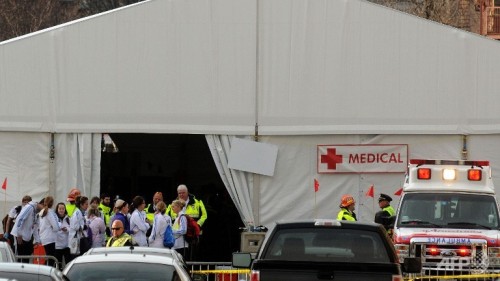
When the Routine Changes
Having been involved in the medical coverage of sporting events for some time, the process of packing a medical kit has become a less daunting task and more of a standardized process. Throw in a few pairs of gloves. Toss in some bandages and gauze. Squeeze in a sling and a few rolls of tape. While these basic supplies might be all we end up using, we eventually get around to including the equipment we’d associate with more life-threatening situations. In go the pocket mask, oral airways and collars. Things that we hope never see the light of day once nestled inside the dark confines of our packs.
As sports first responders we are trained to plan for the worst outcome, but we always hope for the best. Even though we approach each event with this thought process, I don’t know that any of us would be mentally prepared for the type of catastrophe that occurred at the Boston Marathon on April 15, 2013. As two bombs exploded among the crowds gathered at the Boylston St. finish line, medical staff would have the daunting task of immediately shifting their attention away from the dehydrated runners and focusing all their efforts on saving the lives of those affected by the blast.
Prior to any sporting event, the medical team will develop an emergency action plan (EAP). In the event of an emergency, this plan is designed to ensure that everyone is aware of their roles. It provides details such as contact information for EMS, directions to the event, access routes for emergency vehicles and other vital information. Once developed, the team will rehearse this plan multiple times in order to maximize efficiency and limit mistakes. Given the sheer number of injuries and taking into consideration the severity, this plan would have been stressed and strained to its limits. Add in the uncertainty surrounding the situation (Was it safe to be in the area? Did it need to be evacuated?) and first responders were working out of an entirely different playbook.
[php snippet=1]
While one of the duties of a first responder is to control the crowd, I was heartened to see responders and regular bystanders working together to rip down security barriers that were separating them from the injured. In the face of the mounting need for supplies, I saw the resourcefulness of responders and bystanders as they used whatever they could to stop the bleeding.
I was astonished by the story of the now famous “Man in the Hat”, who leapt a fence to help a man whose shirt was on fire. He beat out the flames with his hands and used his shirt as a tourniquet as the young man had lost both his lower legs. I saw the picture of him staying by this young man’s side as emergency personnel rushed him to an ambulance.
Beyond the provision of medical services, I was heartened by the response of the citizens of the City of Boston. With portions of the city closed off and transit affected, I heard stories of locals offering rides to competitors from out of town and of beds being offered to those who didn’t have a place to stay. This was a city that mobilized itself to help others.
The marathon bombings can only be described as tragic and senseless and may forever change how we plan and prepare for emergencies at mass sporting events. It was a reminder to all first responders to be prepared for a safe situation to change in a moment’s notice. In the face of terrible sadness, the actions of those involved in the rescue effort stood in stark contrast to this despicable act. My spirits were buoyed by the selflessness, cooperation and dedication of both first responders and bystanders alike. It reminded me of the kinder, more caring side of human nature. The side that rushes to help, gives someone a ride, provides a bed and saves a life. These events have caused me to re-evaluate my role in emergency medical care, and have strengthened my resolve to always be a part of the team.
[php snippet=1]

